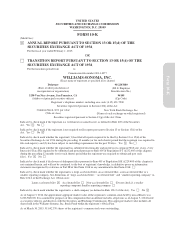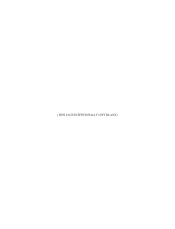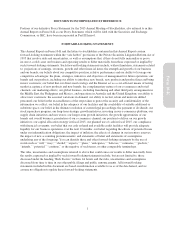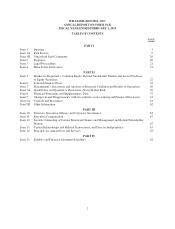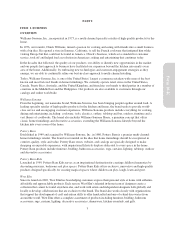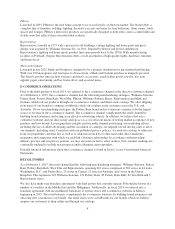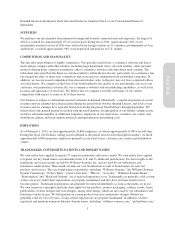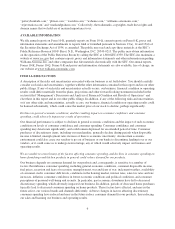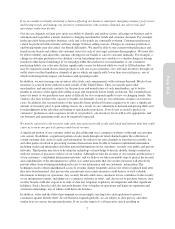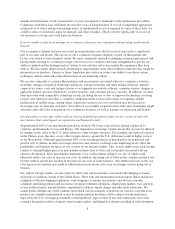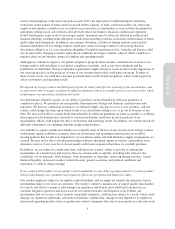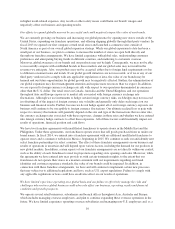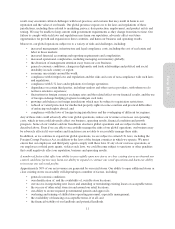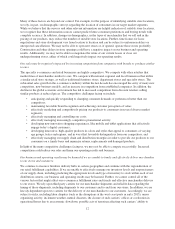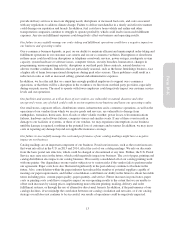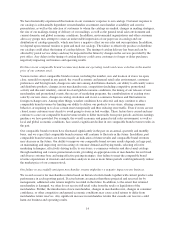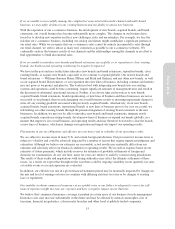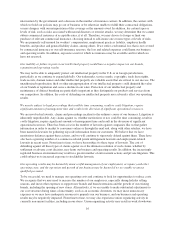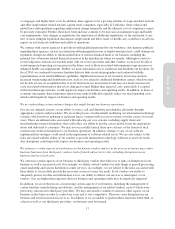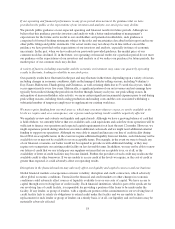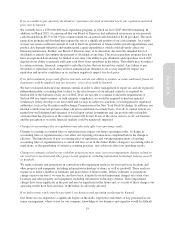Pottery Barn 2014 Annual Report Download - page 23
Download and view the complete annual report
Please find page 23 of the 2014 Pottery Barn annual report below. You can navigate through the pages in the report by either clicking on the pages listed below, or by using the keyword search tool below to find specific information within the annual report.
(such as the disruptions at the west coast ports in early 2015), the imposition of additional import restrictions,
restrictions on the transfer of funds and/or increased tariffs or quotas, or both, could increase the cost, reduce the
supply of merchandise available to us, or result in excess inventory if merchandise is received after the planned or
appropriate selling season, all of which could adversely affect our business, financial condition and operating
results. Furthermore, some or all of our foreign vendors’ operations may be adversely affected by political and
financial instability resulting in the disruption of trade from exporting countries, restrictions on the transfer of funds
and/or other trade disruptions. In addition, an economic downturn, or failure of foreign markets, may result in
financial instabilities for our foreign vendors, which may cause our foreign vendors to decrease production,
discontinue selling to us, or cease operations altogether. Our global operations in Asia, Australia and Europe could
also be affected by changing economic and political conditions in foreign countries, either of which could have a
negative effect on our business, financial condition and operating results.
Although we continue to improve our global compliance program, there remains a risk that one or more of our
foreign vendors will not adhere to our global compliance standards, such as fair labor standards and the
prohibition on child labor. Non-governmental organizations might attempt to create an unfavorable impression of
our sourcing practices or the practices of some of our foreign vendors that could harm our image. If either of
these events occurs, we could lose customer goodwill and favorable brand recognition, which could negatively
affect our business and operating results.
We depend on foreign vendors and third party agents for timely and effective sourcing of our merchandise, and
we may not be able to acquire products in sufficient quantities and at acceptable prices to meet our needs, which
would impact our operations and financial results.
Our performance depends, in part, on our ability to purchase our merchandise in sufficient quantities at
competitive prices. We purchase our merchandise from numerous foreign and domestic manufacturers and
importers. We have no contractual assurances of continued supply, pricing or access to new products, and any
vendor could change the terms upon which it sells to us, discontinue selling to us, or go out of business at any
time. We may not be able to acquire desired merchandise in sufficient quantities on terms acceptable to us. Better
than expected sales demand may also lead to customer backorders and lower in-stock positions of our
merchandise, which could negatively affect our business and operating results. In addition, our vendors may have
difficulty adjusting to our changing demands and growing business.
Any inability to acquire suitable merchandise on acceptable terms or the loss of one or more of our foreign vendors
or third party agents could have a negative effect on our business and operating results because we would be
missing products that we felt were important to our assortment, unless and until alternative supply arrangements are
secured. We may not be able to develop relationships with new third party agents or vendors, and products from
alternative sources, if any, may be of a lesser quality and/or more expensive than those we currently purchase.
In addition, we are subject to certain risks that could limit our vendors’ ability to provide us with quality
merchandise on a timely basis and at prices that are commercially acceptable, including risks related to the
availability of raw materials, labor disputes, work disruptions or stoppages, union organizing activities, vendor
financial liquidity, inclement weather, natural disasters, general economic and political conditions and
regulations to address climate change.
If our vendors fail to adhere to our quality control standards, we may delay a product launch or recall a product,
which could damage our reputation and negatively affect our operations and financial results.
Our vendors might not adhere to our quality control standards, and we might not identify the deficiency before
merchandise ships to our stores or customers. Our vendors’ failure to manufacture or import quality merchandise
in a timely and effective manner could damage our reputation and brands, and could lead to an increase in
customer litigation against us and an increase in our routine insurance and litigation costs. Further, any
merchandise that we receive, even if it meets our quality standards, could become subject to a recall, which could
damage our reputation and brands, and harm our business. Additionally, changes to the legislative or regulatory
framework regarding product safety or quality may subject companies like ours to more product recalls and result
9
Form 10-K


